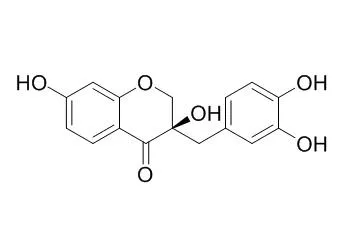| In vitro: |
| Phytomedicine. 2014 Jun 15;21(7):936-41. | | Synergy of aminoglycoside antibiotics by 3-Benzylchroman derivatives from the Chinese drug Caesalpinia sappan against clinical methicillin-resistant Staphylococcus aureus (MRSA).[Pubmed: 24703330] |
METHODS AND RESULTS:
The in vitro antimicrobial activities of three 3-Benzylchroman derivatives, i.e. Brazilin (1), Brazilein (2) and Sappanone B (3) from Caesalpinia sappan L. (Leguminosae) were assayed, which mainly dealt with synergistic evaluation of aminoglycoside and other type of antibiotics against methicillin-resistant Staphylococcus aureus (MRSA) by the three compounds through the Chequerboard and Time-kill curve methods.
The results showed that Compounds 1-3 alone exhibited moderate to weak activity against methicillin-susceptible S. aureus (MSSA) and other standard strains by MICs/MBCs ranged from 32/64 to >1024/>1024 μg/ml, with the order of activity as 1>2>3. Chequerboard method showed significant anti-MRSA synergy of 1/Aminoglycosides (Gentamicin, Amikacin, Etimicin and Streptomycin) combinations with (FICIs)50 at 0.375-0.5. The combined (MICs)50 values (μg/ml) reduced from 32-128/16-64 to 4-8/4-16, respectively.
The percent of reduction by MICs ranged from 50% to 87.5%, with a maximum of 93.8% (1/16 of the alone MIC). Combinations of 2 and 3 with Aminoglycosides and the other antibiotics showed less potency of synergy. | | Zhongguo Zhong Yao Za Zhi. 2009 Mar;34(6):731-4. | | Vasorelaxation effects of homoisoflavonoids from Caesalpinia sappan in rat thoracic aortic rings.[Pubmed: 19624017] | To identify and elucidate the vasorelaxant activity of homoisoflavonoids, the main chemical components from Lignum Sappan (the stems of Caesalpinia sappan), in isolated rat thoracic aortic rings pre-contracted with phenylephrine (PE, 1 micromol x L(-1)) and KCl (60 mmol x L(-1)).
METHODS AND RESULTS:
The tension of rat thoracic aorta rings was used to evaluated the vasorelaxant activities of four homoisoflavonoids, brazlin (1), (E)-3-(3,4-dihydroxybenzylidene)-7-hydroxychroman-4-one (2), Sappanone B (3), 3-deoxySappanone B (4).Cumulative addition of homoisoflavonoids (2, 3 and 4) (50-1000 micromol x L(-1)) exhibited an acute relaxation either in endothelium-intact or endothelium-denuded rings in a concentration-dependent manner. However, this relaxation was significantly inhibited in endothelium-denuded condition and in the presence of endothelial nitric oxide synthase (eNOS) inhibitor, N(W)-nitro-L-arginine methyl ester (L-NNA, 100 micromol x L(-1)), and a soluble guanylate cylcase (sGC) inhibitor, methylene blue (MB, 10 micromol x L(-1)) when addition of variation homoisoflavonoids brazlin (1) (50-1000 micromol x L(-1)).
CONCLUSIONS:
These results indicate that normo-homoisoflavonoids (2, 3 and 4) from Caesalpinia sappan mediates endothelium-independent vasodilator action in rat thoracic aortic rings, while the variation homoisoflavonoids brazlin elicits endothelium-dependent relaxation might via nitric oxide (NO)-cGMP pathway. This research could explain the pharmacological activities of homoisoflavonoids to a certain degree. |
|






 Cell. 2018 Jan 11;172(1-2):249-261.e12. doi: 10.1016/j.cell.2017.12.019.IF=36.216(2019)
Cell. 2018 Jan 11;172(1-2):249-261.e12. doi: 10.1016/j.cell.2017.12.019.IF=36.216(2019) Cell Metab. 2020 Mar 3;31(3):534-548.e5. doi: 10.1016/j.cmet.2020.01.002.IF=22.415(2019)
Cell Metab. 2020 Mar 3;31(3):534-548.e5. doi: 10.1016/j.cmet.2020.01.002.IF=22.415(2019) Mol Cell. 2017 Nov 16;68(4):673-685.e6. doi: 10.1016/j.molcel.2017.10.022.IF=14.548(2019)
Mol Cell. 2017 Nov 16;68(4):673-685.e6. doi: 10.1016/j.molcel.2017.10.022.IF=14.548(2019)